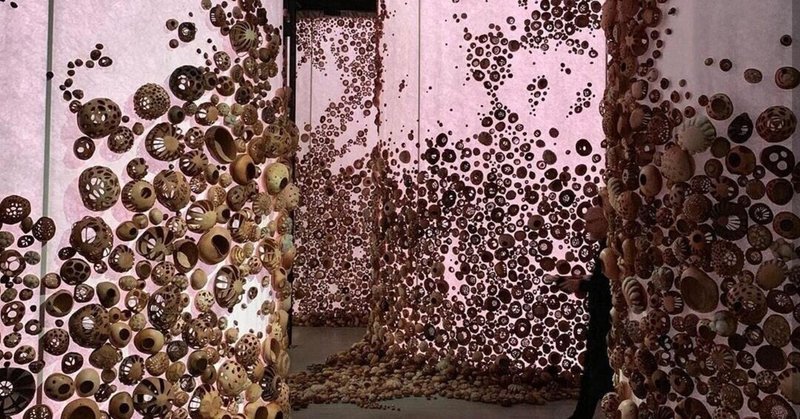
大地から読み解く私たちの過去と現在:中東のランドアートとは|Zahra Al Ghamdi(ザーラ・アルガンディ)
The English translation is given after the Japanese article.
今回は、2019年に開催されたベネチア・ビエンナーレのサウジアラビア館の代表として選出されたアーティストZahra Al Ghamdi(ザーラ・アル・ガンディ)を紹介したいと思います。
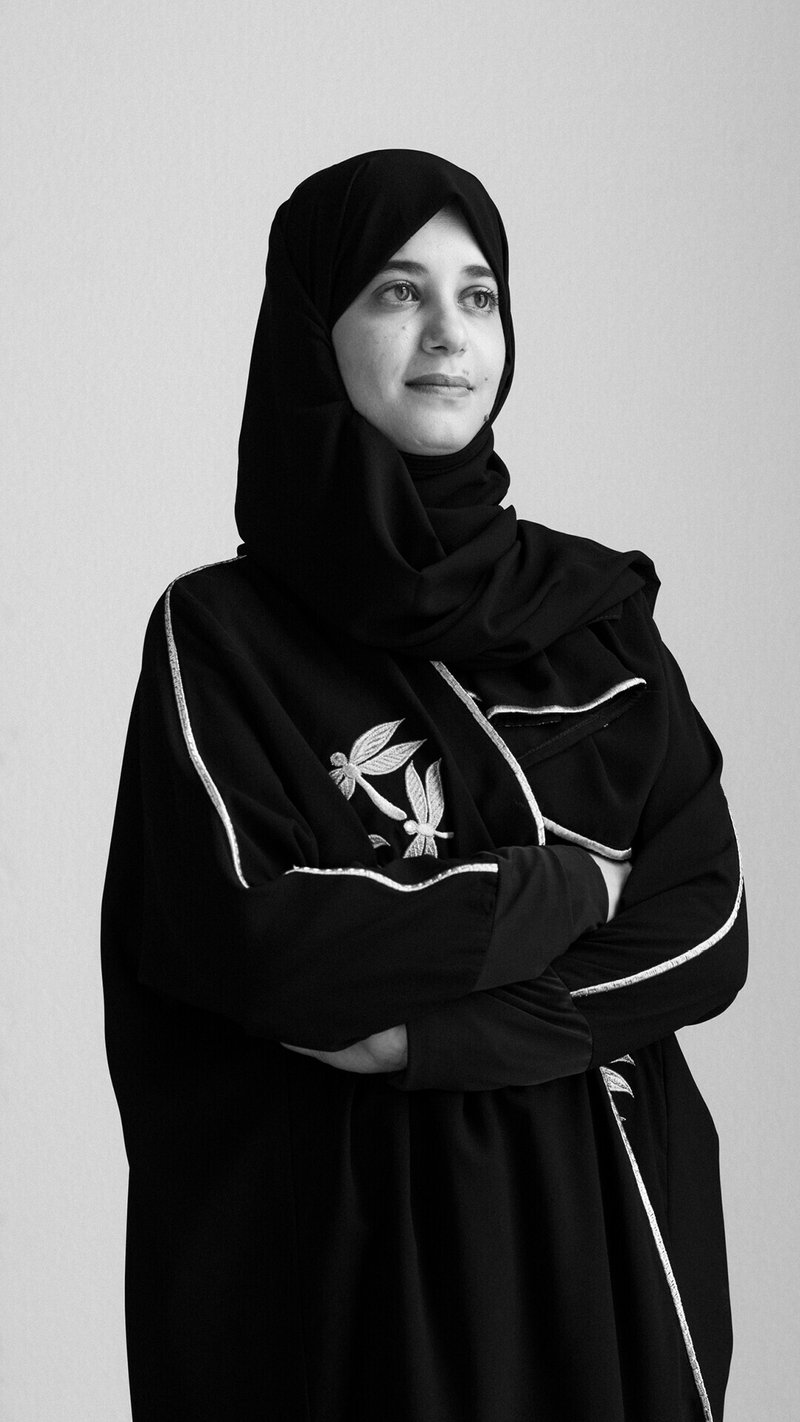
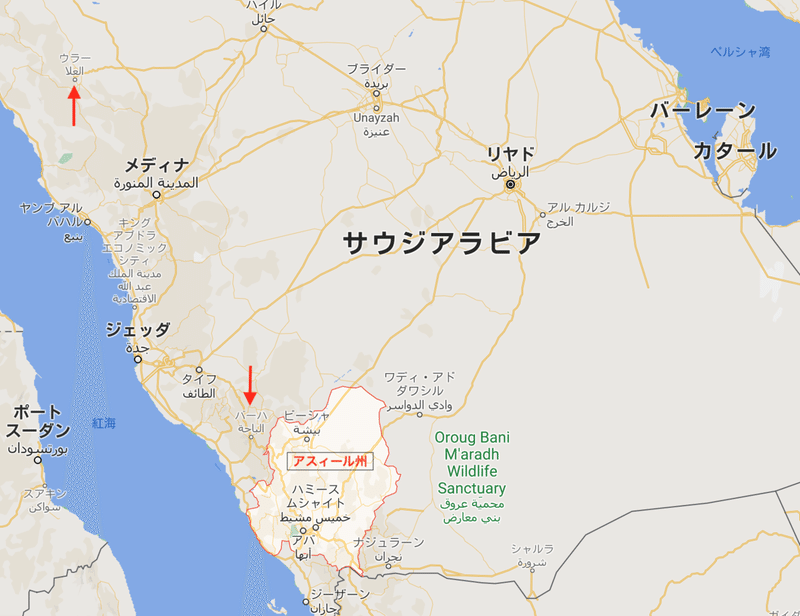
1977年にサウジアラビアの南西部の町バーハに生まれ、2003年にジェッダのキング・アブドゥルアズィーズ大学でイスラム芸術の学士号を取得しました。2009年には、イギリスのコベントリー大学で現代工芸の修士号を、2013年には、同大学でデザイン&ビジュアルアートの博士号を取得しています。そして、現在はジェッダ大学のアート&デザイン学部の助教授を務めています。

彼女の作品は、サイトスペシフィックで土、粘土、石、革、水などの粒子をアッサンブラージュするという時間と労力を要しかつ細部まで行き届いたプロセスによって作り上げられるインスタレーションで、「統合された記憶」という概念を用いて、文化的アイデンティティや記憶、喪失といったテーマを表現しています。伝統的なアスィールの建築に囲まれて育ったことが、彼女の活動に重要な役割をもたらしており、彼女はこれらの建築物における記憶と過去を探究し、作品に過去の慣習の名残を呼び起こします。
“It’s important for me to smell the sand and feel it with my own hands, because those senses of touch and smell allow my work a synergy, and if I don’t get that synergy, I can’t work. The sand should smell natural, like the smell of rain on land, the smell that manifests like steam when it rains” - Zahra Al Ghamdi
"砂の匂いを嗅いだり、自分の手で感じたりすることが大切です。その触覚や嗅覚が私の作品に相乗効果をもたらし、その相乗効果が得られなければ作品になりません。砂の匂いは、地上に降った雨の匂いや、雨が降ったときに蒸気のように現れる匂いなど、自然な匂いがするはずです。”
Glimpses of the Past
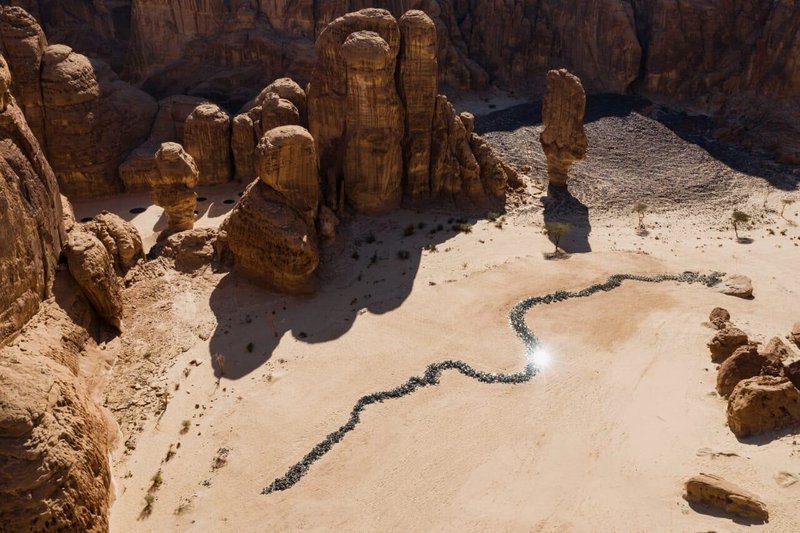
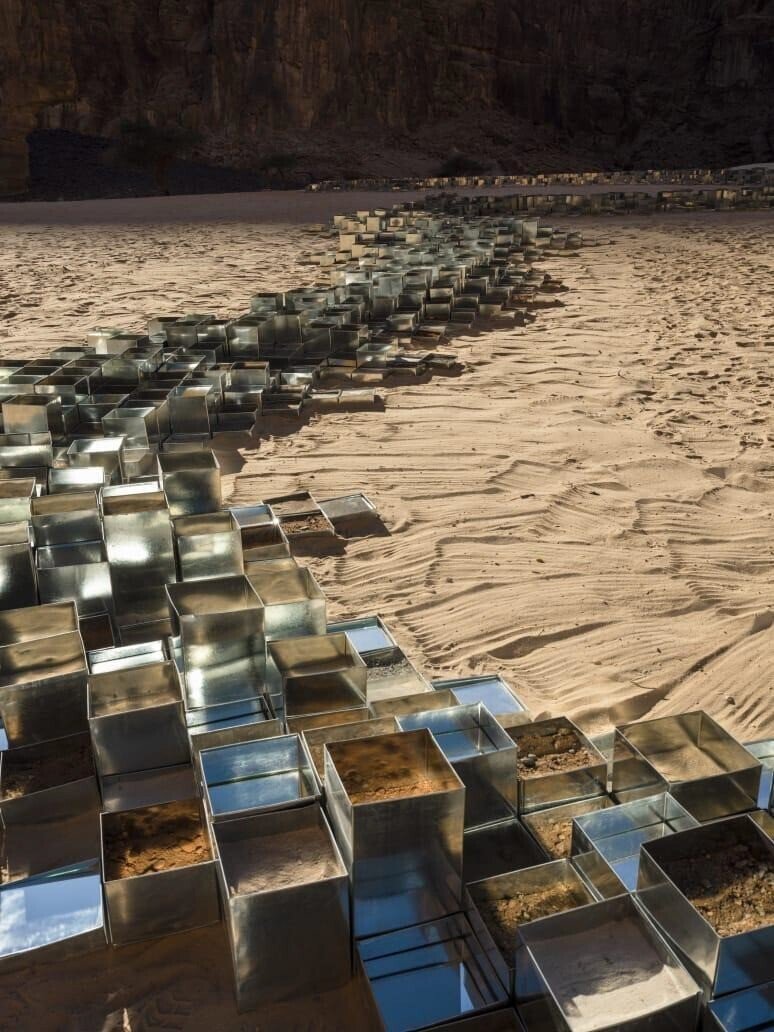
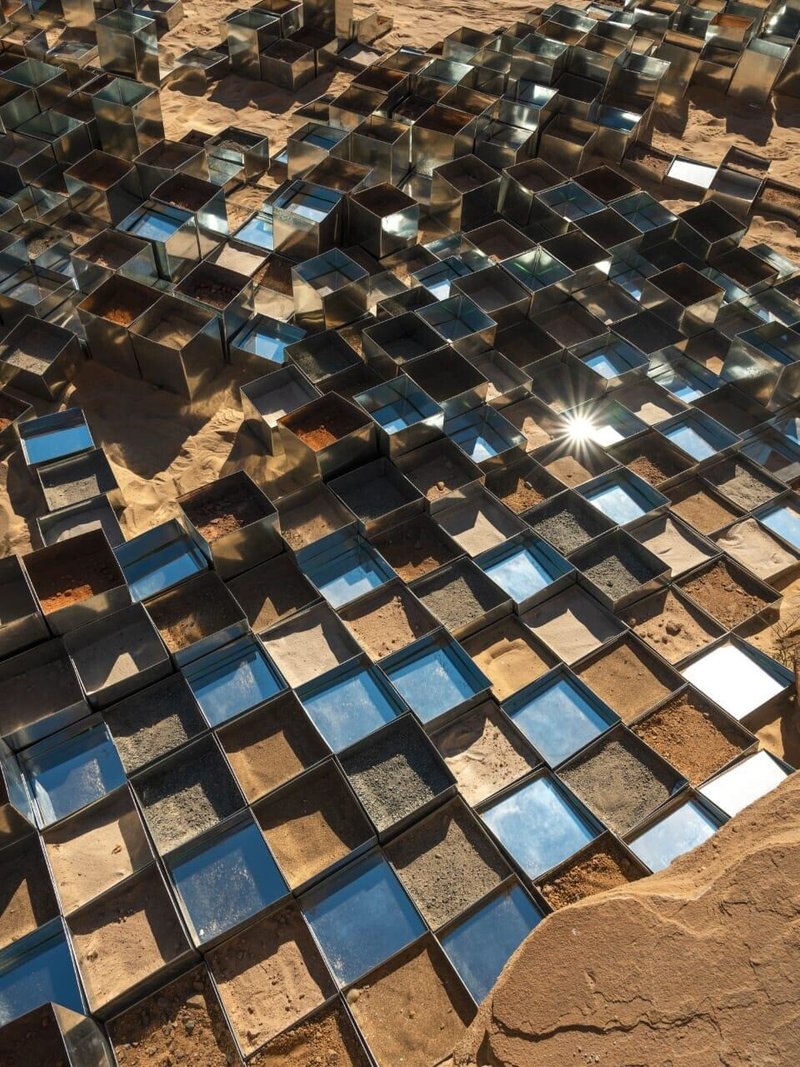
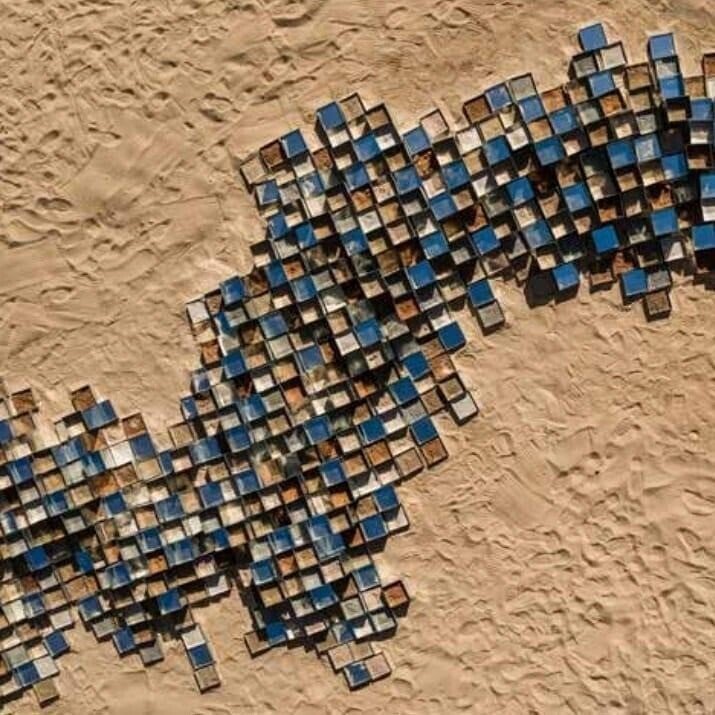
“Glimpses of the Past”
installation view at Desert X AlUla, photo by Lance Gerber.
© Zahra Al Ghamdi. Courtesy the artist, RCU and Desert X.
これは、2020年にアル・ウラーの砂漠で開催された”Desert X AlUla”展で発表されたインスタレーション作品です。アル・ウラーの地形に合わせて80メートルにわたって大きさの異なる約6000個のデーツの缶詰容器が配置されました。この無機質な缶詰の連なりは、複数の支流をもつ川のような有機的な形を成し、それぞれの容器に入れられた5色の砂と鏡によって周囲の風景の中に溶け込んでいきます。
もともとこの地域は、水源地がありヤシの木が豊富に生え、貿易の中心地として機能していました。今では、観光名所として世界中の人々が訪れる文化の中心地になっています。
この作品を見ると、時代を経て機能が変化してきたこの地域の流れを思い起こさせるとともに、”過去を垣間見る”というタイトルからも、アル・ウラーという場所の記憶に私たちを誘ってくれているように感じます。
今年の”Desert X AlUla”展にも作品を出展しているので、ご興味のある方は参考リンクからご覧ください。
*Desert X(デザート・エックス): 世界的に著名なアーティストによるサイトスペシフィックなインスタレーションを通じて、砂漠地帯を活性化する国際的な現代アート展を定期的に開催することを目的に、カリフォルニア州で設立された非営利の慈善団体です。
Ashjan Village
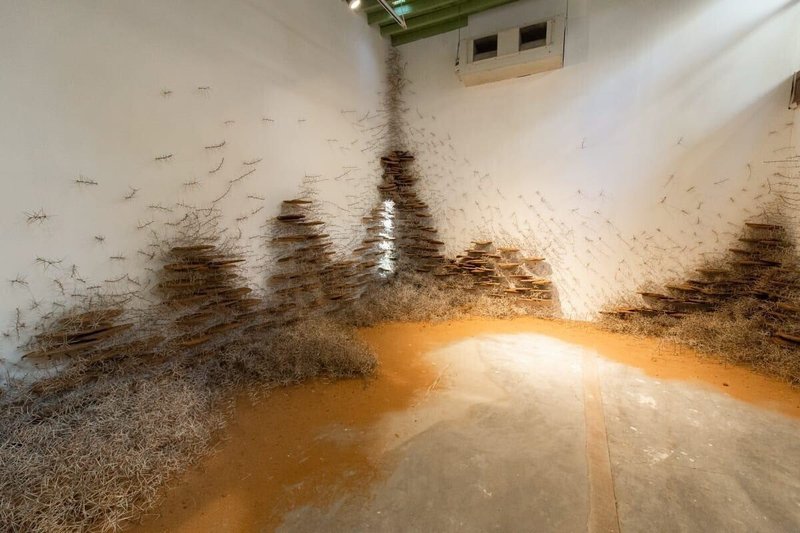
"Ashjan Village"
© Zahra Al Ghamdi. Courtesy the artist and the Saudi Art Council.
サウジアラビアは、人口増加に伴い、急速な都市化とグローバル化の影響で、生活環境が様変わりしました。彼女の住んでいたバーハの建築は、南西部特有のものでしたが、貿易や商業力、そして近代的な生活様式によって形成された都市環境に変容していきました。この作品は、彼女の幼少期に経験した建築の細部の装飾や技術を利用しています。耐久性と回復力を象徴するアカシアは、場所と時間の詩的なシンボルとしても、ベドウィン(アラブ系遊牧民)が繁栄する環境を体現しています。ここでは、素材、プロセス、ジェスチャーが、忍耐、持続、文化的保存の概念を包含しています。彼女が用いる「統合された記憶」という概念に見られるように、過去と現在の結びつきは、「ホーム」が簡単に取り壊せる概念ではなく、共有された集団的な記憶の一部として存在することを示しています。しかし、時が経つにつれて、この2つの生活様式のアイデンティティや地域との関連は、疎外されつつあることを物語ってもいます。
The House
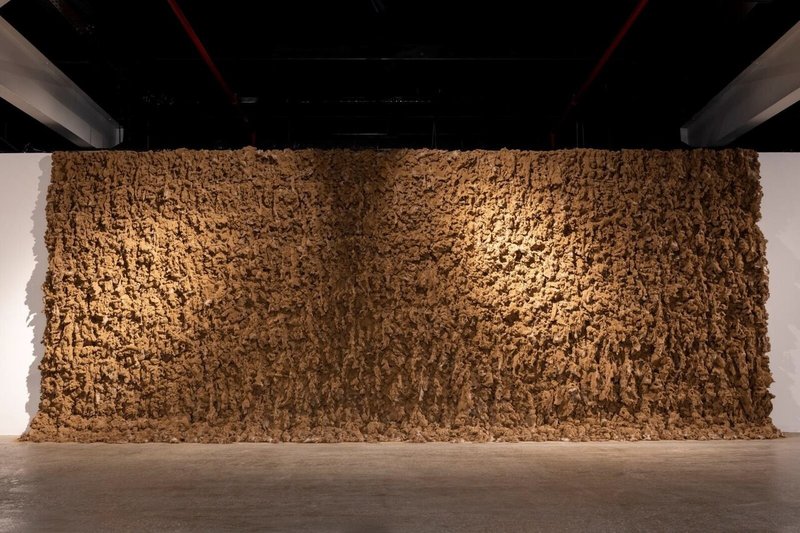
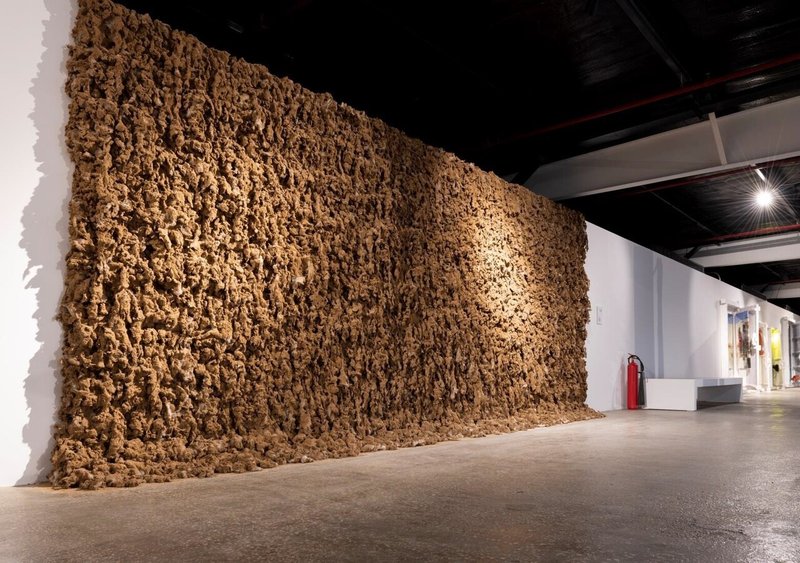
“The House”
© Zahra Al Ghamdi.
この作品は、600枚の布と加工された砂の塊によるインスタレーションです。大量の砂とのりと裏打ちされた布を使って粘土を混ぜ合わせ、さらに直接布に粘土をつけ、最後に手やバーナーでひび割れを作っていきます。この質感は、泥の家に使われていた現地の建築方法を示していますが、ひび割れはこれらの伝統的な原型が破壊されたことを表しています。これは、過去と現在の間の分裂を浮き彫りにし、現在と未来への影響とその影響の受け方について考えさせられます。
Streams Move Oceans
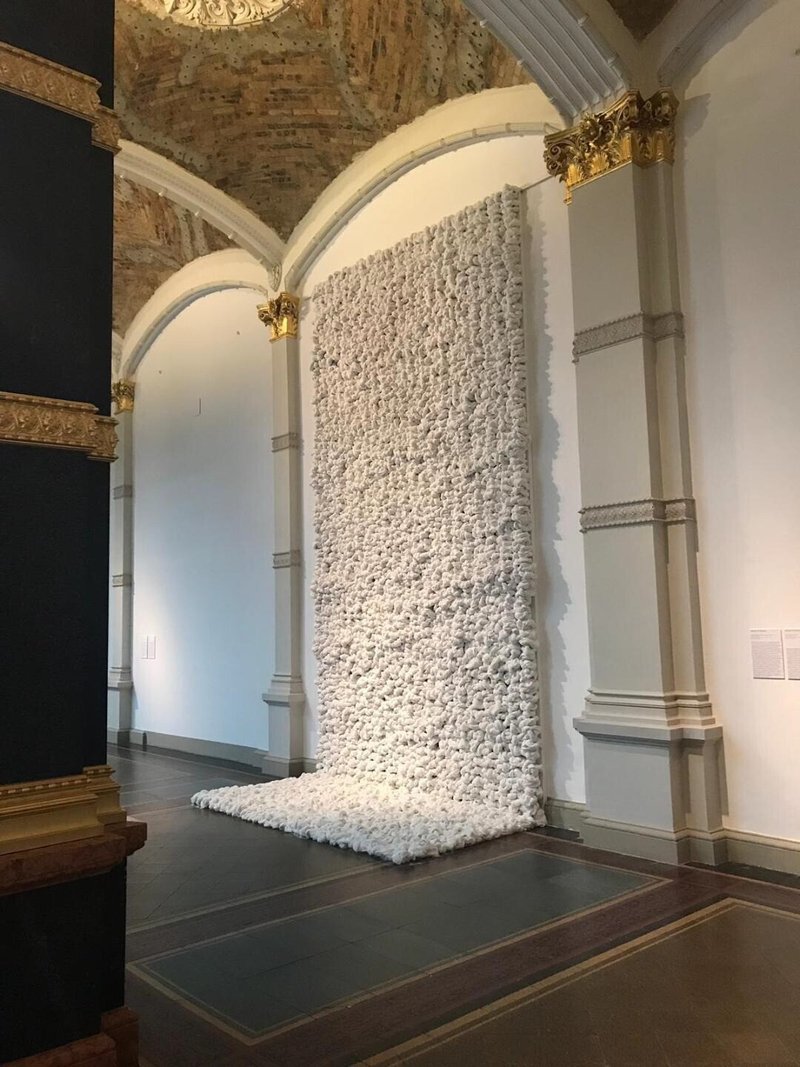
“Streams Move Oceans”
installation view "Walking Through Walls" at the Gropius Bau, Berlin, Germany.
© Zahra Al Ghamdi.
私たちの生活や幸福の核となるのは、つながりや友情、愛であり、2つのモノや2人の間をつなぐ人間関係です。また、それは人やモノの間のダイナミズムであり、その不思議な力は多様で複雑です。人間関係はわかりにくく、疑問を持ち始めると、複雑に絡み合った関係性の網の目に直面することになります。社会文化的なヒエラルキーや経済的地位などが、人間関係のダイナミズムに影響を与え、また人によって視点や優先順位が異なるために、関係性の大きな変化や複雑さがよく現れます。この作品は、散発的に配置された結び目によって構成され、その複雑な関係性を表しています。
What Lies Behind the Sun
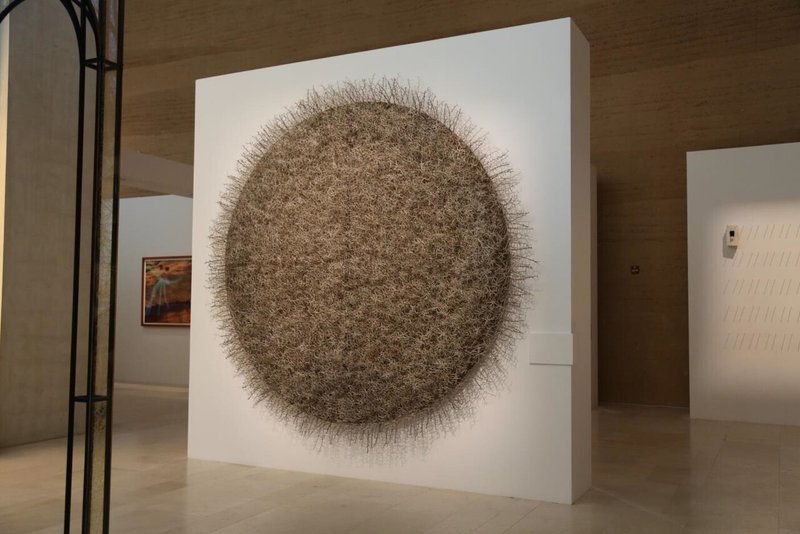

“What Lies Behind the Sun”
installation view in King Abdulaziz Center for World Culture (Ithra), Dhahran, KSA.
© Zahra Al Ghamdi.
砂漠の象徴でもあるアカシアは、枝が絡み合い影を広げることで、過酷な気候でも耐えることができます。また、時が経つにつれて葉を落としていくが、力強さの証として棘が現れ、その強靭さを保ちます。アカシアは、ベドウィンが繁栄する環境において、砂漠の遺産や遊牧民の生活と歴史的に密接に関連しています。この作品では、人類の社会的・経済的発展が気候に与えた影響や、アカシアをはじめとする多くの種が直面している生息地の喪失に焦点を当てています。
お墓は都市や住民から離れた場所にあることが多いですが、アカシアも同様に人里離れた場所で大地に根を張っているという意味で、この二つの要素を重ね合わせて表現しています。
Mycelium Running
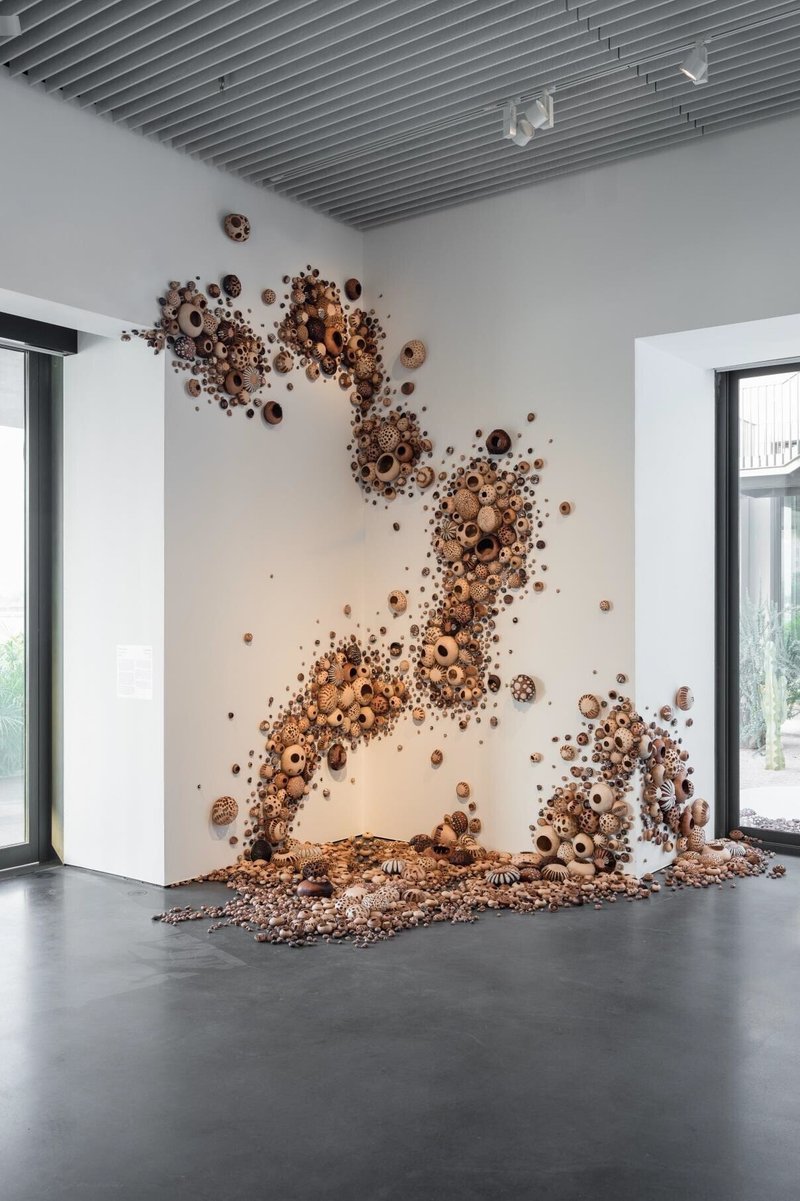
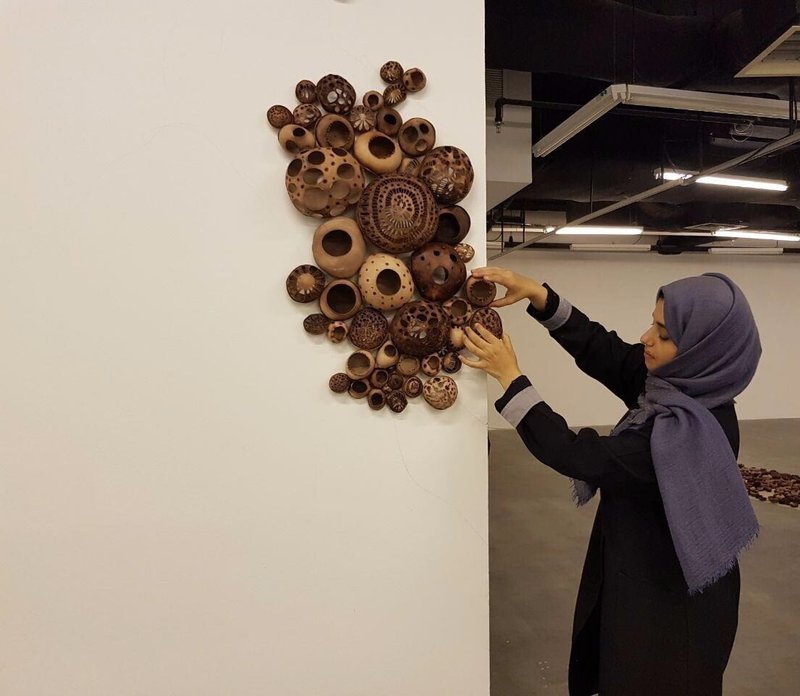
“Mycelium Running”
installation view at Jameel Arts Centre, Dubai.
© Zahra Al Ghamdi.
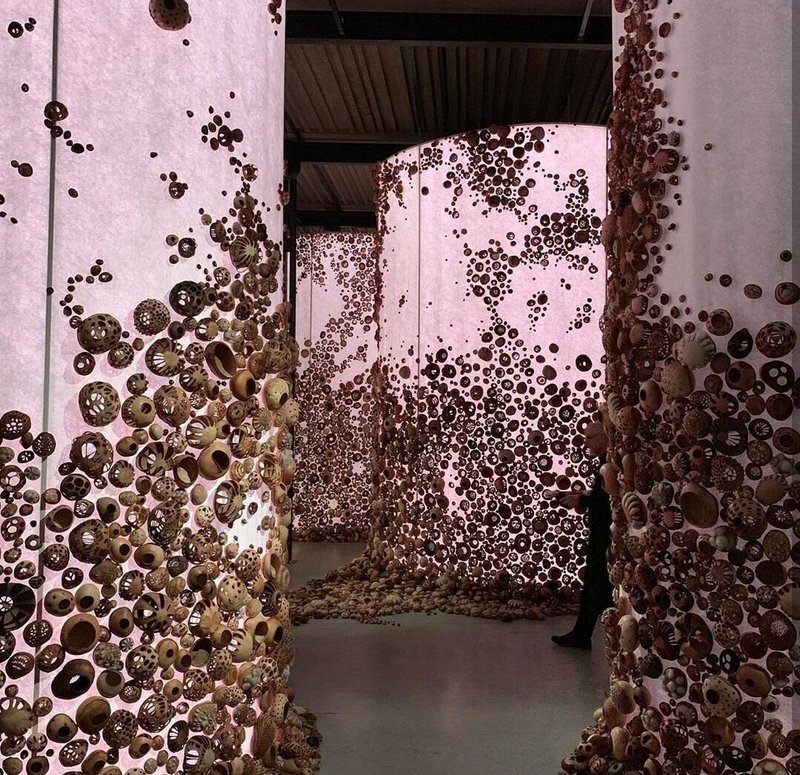
“Mycelium Running”
installation view in the Saudi Pavilion at the Venice Biennale.
© Zahra Al Ghamdi.
使用している素材は、手作業で成形され焼かれた革に綿毛を詰め、水に浸してから空洞にして固めた有機的な素材の塊であり、その形成過程は全体の形と同様に不明瞭で複雑であると言えます。これらの形態が生きているのかどうか、動物なのか有機物なのか、はたまた単に正体不明なのかは定かではありません。置かれた位置によって、それらは自分自身の生命を持ち、部分的に増殖し、彼らが居着くことを許された環境に敏感に適応します。汚染が深刻化する中、人類の未来と地球を守るための鍵は、私たちが残していく世界を消化する菌類ネットワークの神経系が自然のままに露出している私たちの足元にあるのかもしれません。
彼女はこの他にも多くの作品を制作していますが、今回の記事では近年制作した作品にフォーカスして紹介させていただきました。
彼女の作品に興味を持たれた方は、下記に彼女のインスタグラムや参考記事などのリンクを載せていますので、是非ご覧ください。
Faisal Khalaf
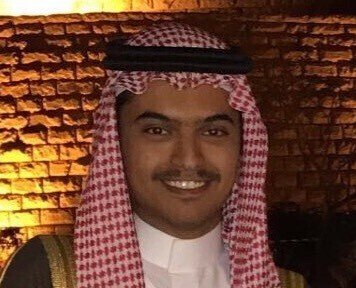
【参考リンク Reference links】
Instagram
https://www.instagram.com/Dr.zahrah_alghamdi/
Desert X
Venice Biennale 2019
Misk Art Institute
Jameel Arts Centre
[English version]
I would like to introduce you to Zahra Al Ghamdi, the artist selected to represent the Saudi Pavilion at the Venice Biennale in 2019.
She was born in 1977 in the south-western Saudi town of Al Bahah and graduated in 2003 with a BA in Islamic Arts from King Abdulaziz University in Jeddah. In 2009 she gained an MA in Contemporary Craft from Coventry University, UK and in 2013 a PhD in Design & Visual Arts from the same university. She is currently an Assistant Professor at the Faculty of Art and Design, University of Jeddah.
Her work is a site-specific, laborious and meticulous process of an assemblage of particles of earth, clay, rocks, leather and water. The installation uses the notion of 'embodied memory' to express themes of cultural identity, memory and loss. Growing up surrounded by traditional Asir architecture has played an important role in her practice, and she explores the memory and past in these buildings, evoking remnants of past ethos in her work.
“It’s important for me to smell the sand and feel it with my own hands, because those senses of touch and smell allow my work a synergy, and if I don’t get that synergy, I can’t work. The sand should smell natural, like the smell of rain on land, the smell that manifests like steam when it rains” - Zahra Al Ghamdi
Glimpses of the Past
This is an installation work presented at the Desert X AlUla exhibition in 2020 in the desert of AlUla. Some 6,000 tin containers of dates of different sizes were placed over 80 metres of the AlUla terrain. This inorganic series of tins takes on an organic form, like a river with multiple tributaries, and blends into the surrounding landscape with the five colours of sand and mirrors placed in each container. Originally the area was a trading centre, with a water source and an abundance of palm trees. Today, it is a tourist attraction and a cultural centre visited by people from all over the world. The work reminds us of the way the area has changed its function over time, and the title "Glimpses of the Past" invites us to remember the memory of AlUla as a place.
If you are interested in seeing her work in this year's "Desert X AlUla" exhibition, please click on the reference link above.
*Desert X: A non-profit charitable organization founded in California to regularly present international contemporary art exhibitions that revitalize desert areas through site-specific installations by world-renowned artists.
Ashjan Village
Saudi Arabia's growing population, rapid urbanisation and globalisation have transformed living conditions. The architecture of Al Bahah where she lived was characteristic of the South West but was transformed into urban settings shaped by trade, commercial prowess and modern ways of life. This work makes use of the architectural details and techniques she experienced in her childhood. Symbolising durability and resilience, the acacia is also a poetic symbol of place and time, embodying the environment in which the Bedouin (Arab nomads) thrive. Here, materials, processes and gestures embrace the concepts of patience, persistence and cultural preservation. The link between past and present, as seen in the concept of 'embodied memory' she uses, shows that 'home' is not a concept that can be easily demolished, but exists as part of shared collective memory. But it also tells us that, over time, the identity of these two ways of life and their relationship to the region are becoming alienated.
The House
The work is an installation of 600 pieces of cloth and fabricated sand blocks. The clay is mixed using large amounts of sand, glue and lined cloth, then the clay is applied directly to the cloth and finally, cracks are made by hand or with a burner. The texture is indicative of the vernacular building methods used for the mud houses, but the cracks show that these traditional archetypes have been destroyed. This highlights the divide between the past and the present and makes us think about the present and its impact on the future and how we are affected by it.
Streams Move Oceans
At the heart of our lives and our happiness are connections, friendships and love, relationships that connect two things or two people. It is also a dynamism between people and things, whose alchemy is diverse and complex. Relationships are difficult to understand and when you start to question them, you are confronted with a complex web of intertwined relationships. Socio-cultural hierarchies and economic status influence the dynamism of relationships and, because different people have different perspectives and priorities, differences and complexities in relationships often emerge. The work is made up of sporadically placed knots, representing the complexity of the relationship between them.
What Lies Behind the Sun
An icon of the desert, the acacia can withstand the harshest climates due to its intertwining branches and spreading shadows. It also sheds its leaves over time but retains its resilience with the appearance of thorns as a sign of strength. Acacia is historically closely associated with desert heritage and nomadic life in an environment where the Bedouin thrive. This work focuses on the impact of human social and economic development on the climate and the loss of habitat faced by Acacia and many other species. Graves are often located away from cities and populations, and the acacia is similarly remote and rooted in the earth, so the two elements are superimposed to express this.
Mycelium Running
The material used is a mass of organic material, hand moulded and burnt leather, stuffed with cotton wool, then immersed in water and hollowed out to harden, a process that is as obscure and complex as the overall shape. It is not clear whether these forms are living, animal, organic substance or simply unidentified. Depending on their position, they take on a life of their own, partially multiplying and sensitively adapting to the environment in which they are allowed to settle. As pollution worsens, the key to protecting the future of humanity and our planet may lie at our feet, where the nervous system of the fungal network that digests the world we are leaving behind is exposed in its natural state.
She has produced many other works, but for this article, I had focused on her recent work. If you are interested in her work, you can find links to her Instagram and reference articles above.
Faisal Khalaf
この記事が気に入ったらサポートをしてみませんか?
